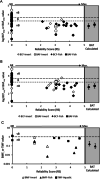Acritical review and weight of evidence approach for assessing the bioaccumulation of phenanthrene in aquatic environments
- PMID: 33620129
- PMCID: PMC8451923
- DOI: 10.1002/ieam.4401
Acritical review and weight of evidence approach for assessing the bioaccumulation of phenanthrene in aquatic environments
Abstract
Bioaccumulation (B) assessment is challenging because there are various B-metrics from laboratory and field studies, multiple criteria and thresholds for classifying bioaccumulative (B), very bioaccumulative (vB), and not bioaccumulative (nB) chemicals, as well as inherent variability and uncertainty in the data. These challenges can be met using a weight of evidence (WoE) approach. The Bioaccumulation Assessment Tool (BAT) provides a transparent WoE assessment framework that follows Organisation for Economic Co-operation and Development (OECD) principles for performing a WoE analysis. The BAT guides an evaluator through the process of data collection, generation, evaluation, and integration of various lines of evidence (LoE) (i.e., B-metrics) to inform decision-making. Phenanthrene (PHE) is a naturally occurring chemical for which extensive B and toxicokinetics data are available. A B assessment for PHE using the BAT is described that includes a critical evaluation of 74 measured in vivo LoE for fish and invertebrate species from laboratory and field studies. The number of LoE are reasonably well balanced across taxa (i.e., fish and invertebrates) and the different B-metrics. Additionally, in silico and in vitro biotransformation rate estimates and corresponding model-predicted B-metrics are included as corroborating evidence. Application of the BAT provides a consistent, coherent, and scientifically defensible WoE evaluation to conclude that PHE is not bioaccumulative (nB) because the overwhelming majority of the bioconcentration, bioaccumulation, and biomagnification metrics for both fish and invertebrates are below regulatory thresholds. An analysis of the relevant data using fugacity ratios is also provided, showing that PHE does not biomagnify in aquatic food webs. The critical review identifies recommendations to increase the consistency of B assessments, such as improved standardization of B testing guidelines, data reporting requirements for invertebrate studies, and consideration of temperature and salinity effects on certain B-metrics. Integr Environ Assess Manag 2021;17:911-925. © 2021 Concawe. Integrated Environmental Assessment and Management published by Wiley Periodicals LLC on behalf of Society of Environmental Toxicology & Chemistry (SETAC).
Keywords: Bioaccumulation; Biomagnification; Biotransformation; Phenanthrene; Weight of evidence.
© 2021 Concawe. Integrated Environmental Assessment and Management published by Wiley Periodicals LLC on behalf of Society of Environmental Toxicology & Chemistry (SETAC).
Figures


Similar articles
-
A weight of evidence approach for bioaccumulation assessment.Integr Environ Assess Manag. 2023 Sep;19(5):1235-1253. doi: 10.1002/ieam.4583. Epub 2022 Feb 21. Integr Environ Assess Manag. 2023. PMID: 35049141
-
Methods for assessing the bioaccumulation of hydrocarbons and related substances in terrestrial organisms: A critical review.Integr Environ Assess Manag. 2023 Nov;19(6):1433-1456. doi: 10.1002/ieam.4756. Epub 2023 Apr 12. Integr Environ Assess Manag. 2023. PMID: 36880196 Review.
-
Advancing the weight of evidence approach to enable chemical environmental risk assessment for decision-making and achieving protection goals.Integr Environ Assess Manag. 2023 Sep;19(5):1188-1191. doi: 10.1002/ieam.4803. Integr Environ Assess Manag. 2023. PMID: 37421247 Review.
-
A weight-of-evidence approach for the bioaccumulation assessment of triclosan in aquatic species.Sci Total Environ. 2018 Mar 15;618:1506-1518. doi: 10.1016/j.scitotenv.2017.09.322. Epub 2017 Oct 10. Sci Total Environ. 2018. PMID: 29029804 Review.
-
A Toxicokinetic Framework and Analysis Tool for Interpreting Organisation for Economic Co-operation and Development Guideline 305 Dietary Bioaccumulation Tests.Environ Toxicol Chem. 2020 Jan;39(1):171-188. doi: 10.1002/etc.4599. Epub 2019 Nov 30. Environ Toxicol Chem. 2020. PMID: 31546284
Cited by
-
Guidance for measuring and evaluating biomagnification factors and trophic magnification factors of difficult substances: application to decabromodiphenylethane.Integr Environ Assess Manag. 2025 Mar 1;21(2):263-278. doi: 10.1093/inteam/vjae025. Integr Environ Assess Manag. 2025. PMID: 39886942 Free PMC article. Review.
References
-
- Abelkop ADK, Bergkamp L, Brooks BW, Gergely A, Graham JD, Gray G, van Leeuwen K, Marchant GE, Mueller ML, Royer TV et al. 2013. Scientific and policy analysis of persistent, bioaccumulative, and toxic chemicals: A comparison of practices in Asia, Europe, and North America. The report of a consensus panel. Bloomington (IN): School of Public and Environmental Affairs, Indiana University. 98 p.
-
- Agersted MD, Møller EF, Gustavson K. 2018. Bioaccumulation of oil compounds in the high‐arctic copepod Calanus hyperboreus . Aquat Toxicol 195:8–14. - PubMed
-
- [ARC] ARC Arnot Research & Consulting . 2019. The Bioaccumulation Assessment Tool (BAT). Toronto (ON). [accessed 2020 Jun 1]. http://arnotresearch.com/models/
-
- Arnot JA, Gobas FAPC. 2004. A food web bioaccumulation model for organic chemicals in aquatic ecosystems. Environ Toxicol Chem 23(10):2343–2355. - PubMed
-
- Arnot JA, Gobas FAPC. 2006. A review of bioconcentration factor (BCF) and bioaccumulation factor (BAF) assessments for organic chemicals in aquatic organisms. Environ Rev 14(4):257–297.
Publication types
MeSH terms
Substances
Grants and funding
LinkOut - more resources
Full Text Sources
Other Literature Sources
Miscellaneous

